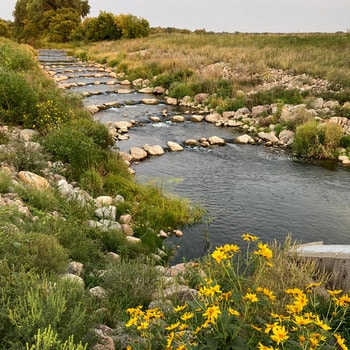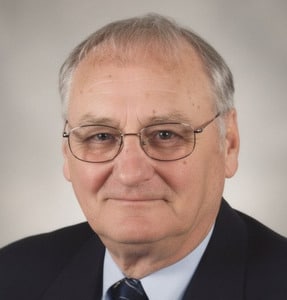The return of redhorse species to a stretch of the Sand Hill River in Polk County reflects improving trends that could lead to removal from the state’s impaired waters list as early as 2026.
“Overall, things are looking much improved in terms of fish passage,” Murphy Steininger, who led the Minnesota Pollution Control Agency monitoring crew and reviewed the results, said in November. “We’ve definitely documented some improvements.”
A lack of redhorse, suckers, and other large-bodied species contributed to the fish-based Index of Biological Integrity (IBI) score that landed a 62-mile-long stretch of the Sand Hill River on the state’s impaired waters list in 2014. It’s also impaired for aquatic recreation because of E. coli.
Fertile is at the midpoint of the 32-mile-long downstream segment showing improvement. Removing the IBI impairment could be proposed for all or part of that downstream segment, where 2011 monitoring turned up no large fish species. Since then, 25 rock riffles and four rock arch rapids have replaced four dams west of Fertile on the Sand Hill River, a Red River tributary.
The $1.6 million riffle and rapids project — backed by a Clean Water Fund grant the Minnesota Board of Water and Soil Resources awarded to the West Polk Soil & Water Conservation District, a match from the Sand Hill River Watershed District, a Minnesota Department of Natural Resources Outdoor Heritage Fund grant and an Enbridge Ecofootprint grant — followed 20 years of watershed-wide work by local, state and federal partners.
The Sand Hill River Watershed District started investigating ways to restore the fishery in 2003. Backed by a DNR grant, the first projects — a new road crossing west of Beltrami and box culverts west of Fertile — finished in 2007.
Ten years later, the U.S. Army Corps of Engineers modified four failing drop structures built in the 1950s to control flooding. The Clean Water Fund-supported work built upon that $7 million ecosystem restoration project, which drew from nearly $5 million in USACE dollars and $1.9 million in Outdoor Heritage Funds. The USACE designed and managed the construction of the project; the watershed district assumed jurisdiction over operation and maintenance.
“The fish are back, and that’s huge,” said West Polk SWCD Manager Nicole Bernd. “We were able to restore the fish habitat, the fish life in that stretch of river.”
The first redhorse appeared in the MPCA’s 2018 monitoring. Since then, three redhorse species have appeared consistently, and the overall number of fish has increased. From 2011 to 2023, the number of overall species recorded increased from 16 to 21.
“The fish community results and composition in the Fertile area seem to be much improved compared to 2011. Our recent samples have documented several larger migratory species that we expect to see in a healthy river of this size,” Steininger said.
“It’s not sturgeon, so it’s not going to get quite the same attention, but it’s still a really cool thing that you now have these fish moving this far upriver. And it’s a direct result of work that they’ve been doing,” Steininger said of work within the watershed.
The MPCA monitors most stations once every 10 years, part of its routine water-quality assessment to determine the need for protection and restoration. Within the 32-mile-long stretch of the Sand Hill River with Fertile at its midpoint, IBI scores are improving at each one of the three monitoring stations.
The westernmost of those, upstream about 5 river miles from the rock riffles and 35 river miles from the Red River, is a long-term monitoring station from which the MPCA routinely collects samples every two years. The most recent sampling, in July 2022, turned up 13 silver redhorse, 10 golden redhorse and four shorthead redhorse. The presence of redhorse species significantly improves three of the 12 metrics used to calculate IBI scores: the percentage of suckers, darters and sculpin; the percentage of pollution- intolerant insectivore species; and the percentage of pollution-intolerant female fish whose reproductive age is at least 3 years old.
Steininger described those metrics as the “catalysts of the increased IBI performance in recent years.”
Meeting water-quality standards for fish-based IBI on the Sand Hill River requires a score of 47 or higher — a threshold surpassed at the long-term monitoring station during the past five samplings: one in 2022, two in 2021, and one each in 2018 and 2016. The 2022 score was 68.
The two sites farther upstream also showed improving trends in the number of species and number of fish, but to a lesser extent. The trends prompted follow-up sampling in 2023. Those initial scores, which await confirmation, do not meet water-quality standards independently. But the improvements could bolster the case for the MPCA to recommend delisting the entire 32-mile stretch.
“It’s absolutely wonderful,” Bernd said of the positive trends. “The Sand Hill River, along with the other main rivers in the Red River Valley, are some of the few recreational areas for fishing. And it’s good fishing. A lot of people see it as just a ditch, but really, it’s a river.”
Smallmouth bass are the most common sportfish to turn up in samples, but Steininger also sees the occasional walleye and Northern pike.
“It’s definitely helping out the sportfish — walleye, bass, even catfish. It helps everything. It helps the whole ecosystem,” Steininger said.
MPCA Environmental Specialist Scott Schroeder, whose territory includes the Sand Hill, Buffalo, Upper Red, and Otter Tail river watersheds, said the riffle project has captured attention throughout the region.
“I hear people talking about how they themselves, or their family members — their children, grandchildren, nieces, nephews — are going out fishing on the river, in places where you couldn’t catch fish previously. And they’re having success and having fun fishing on the Sand Hill River, which they couldn’t have done (previously) because of the old drop structures,” Schroeder said.
While recreational opportunities have brought more anglers and paddlers to the area, Bernd said word-of-mouth about the Sand Hill River project has brought more landowners into the SWCD office seeking erosion-control solutions. The Clean Water Fund-backed project was designed to curb streambank erosion and stabilize the channel — improvements that benefit water quality. (Elsewhere in the watershed, the East Polk SWCD has worked with landowners on Clean Water Fund-backed erosion control projects that curb sediment-loading.)
“All of our work is based on voluntary conservation,” Bernd said. “That (project) has made landowners more aware. They’re more apt to ask for assistance.”
Strong partnerships forged on the Sand Hill River project — which involved staff from the SWCD and watershed district, DNR ecological services and BWSR, plus the USACE — have accelerated water-quality work throughout the region.
“Because we had already collaborated with our partners through the riffles project, it was so easy to come to the table to work on One Watershed, One Plan because those relationships had been established. We had trust built,” said April Swenby, Sand Hill River Watershed District administrator.
Bernd applied for the Clean Water Fund grant and facilitated the riffles project — an experience she said prepared her to facilitate One Watershed, One Plan planning for the Wild Rice-Marsh River, Middle Snake-Tamarack River, and Sand Hill River watersheds.
“I’m not afraid of asking people to be a part of something bigger than themselves. I myself don’t hesitate anymore. And I myself have learned to find the right people to engage,” Bernd said.
The Sand Hill River Watershed District applied for the Outdoor Heritage Fund grant. Its engineering firm, Houston Engineering, worked with the USACE on the dam removal and oversaw the riffles design, permitting, and construction.
Remaining Outdoor Heritage Funds allowed the watershed district to work with the DNR to remove additional barriers to fish passage: a perched culvert on Kittleson Creek, a tributary west of Fertile; the Sand Hill Lake dam near Fosston, which was replaced with rock arch rapids in 2020; and the Poissant Bridge, which was on the verge of sliding into the river in 2021 when it was removed and rock riffles were installed at the site in Fertile. By the time work finished, a total of 33 riffles had been installed within the project area.
Ecosystem enhancements earned the Sand Hill River Watershed District the Minnesota Association of Watershed Districts (now Minnesota Watersheds) 2021 Project of the Year Award.
Now, Swenby said a project team is investigating a potential Sand Hill River ecosystem restoration centered on a 3-mile stretch in Liberty and Reese townships.
“I think that we have a lot more opportunity to continue what we’ve already started,” Swenby said. “In our One Watershed, One Plan, that stretch from where we started the riffles going all the way to Nielsville has been determined a priority area. We have a lot of ideas, and we believe that there is a lot of opportunity out there for growth and improvement.”
Ten years from now, Bernd said she hoped to see continued water-quality improvements in the Sand Hill River watershed.
“I want the whole Sand Hill River to come off the impaired waters list. But I also want to continue working with the watershed district and other partners on other needs or assessments along the Sand Hill,” Bernd said. “The Sand Hill project was an excellent stepping stone to continue conservation, water- quality, and wildlife habitat work.”




